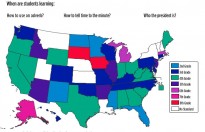Earn an online degree at iCollege
Minnesota’s two-term governor Tim Pawlenty challenged the status quo of higher education when he appeared on The Daily Show with Jon Stewart Thursday night. He talked about the role of government and how we educate our students at the post-secondary level, but the overall message was about efficiency.
“Do you really think in 20 years somebody is going to put on their backpack … haul their keister across campus, and sit and listen to some boring person drone on about econ 101…?” asked Gov. Pawlenty. The segment in which he discussed education can be seen here.
If it seemed unusual for a governor to be on a national television program touting alternative methods of higher education, his timing was perfect. Across the United States, public universities are raising tuitions due to budget cuts, making it harder to afford traditional higher education. Community colleges have become selective because they are oversubscribed.
Enter the innovators.
Burck Smith, an internet entrepreneur and founder of StraighterLine, an online venue for college courses, is “bent on altering the DNA of higher education as we have known it for the better part of 500 years,” wrote Kevin Carey in Washington Monthly. “Rather than students being tethered to ivy-covered quads or an anonymous commuter campus, Smith envisions a world where they can seamlessly assemble credits and degrees from multiple online providers, each specializing in certain subjects and — most importantly — fiercely competing on price.”
Pawlenty is also questioning the status quo.
“Is there another way to deliver the service other than a one-size-fits-all, monopoly provider that says ‘Show up 9 a.m. Wednesday morning for econ 101?’” asked Pawlenty.
Yes! Eager learners can access lectures whenever and wherever they please — assuming they have the technology — via open courseware from MIT, UC Berkeley and other universities. But free online courses don’t necessarily lead to a degree.

Econ 101: Supply and demand curves intersect at the market price. (Image Courtesy MIT OpenCourseWare.)
The U.S. now ranks 10th in the world as measured by the percentage of our population with college degrees. President Barack Obama has set a goal of having the U.S. produce five million more college graduates, with the hope of regaining 1st place by 2020.
Challenging the status quo, though, will require more than simply downloading a lecture.
“The real power of the technology is not delivering the classroom instruction but using technology to change the way we do instruction,’’ said Robert Mendenhall, president and CEO of Western Governors University, a private, not-for-profit online university founded and supported by 19 governors — although Minnesota was not among them. Western Governors University accepted its first students in 1999.
“For higher education to be more effective,” said Mendenhall, “you have to deliver the content and make it self-paced … you have to individualize it.” Like their peers on campus, students communicate with professors using Skype, iChat and email. However, they access their online courses at their convenience, not at set times.
Mendenhall did not watch The Daily Show on Thursday, but he applauds the governor’s open-minded approach to different ways of delivering higher education. He said, however, that it is Pawlenty’s neighbor to the south who is embracing an entirely new and even more innovative system of delivering higher education.
Indiana Gov. Mitch Daniels, a fellow Republican, established WGU Indiana, a partnership between the state and Western Governors University, to expand access to higher education by encouraging students to enroll in online degree programs. Indiana ranks 44th in the country in the percentage of adults with postsecondary credentials, Daniels said last week.
“WGU Indiana will fill the clearest and most challenging gap remaining in our family of higher education opportunities, helping thousands of adult Hoosiers attain the college degrees they’ve wanted and needed, on a schedule they can manage, at a cost they can afford,” Daniels said, in a press release and in remarks broadcast on YouTube.
The average age of a Western Governors University student is 36 years old. So, for students who put off higher education and graduation until later in life, as with their younger counterparts, a degree offers broader professional options and the potential for higher income.
WGU has students in all 50 states, including Minnesota, and 22 percent reside in rural areas with little access to university campuses.
Regardless of age or locale, the reality is that while U.S. college enrollment rates have grown rapidly over the past 40 years, completion rates haven’t kept pace. Bureau of Labor Statistics data show that 70 percent of 2009 high school graduates were enrolled in colleges or universities. However, 30 percent of college and university students drop out after their first year, according to U.S. News and World Report. Half never graduate at all. The idea, of course, is that by offering courses online, more students will be able to complete their post-secondary degree.
WGU enrollment grew from 14,000 to 20,000 students this year. What matters, of course, isn’t how many students enroll but how many of them complete their post-secondary education. Fifty-six percent of full-time, first-time WGU students graduated within 150 percent of “normal time” to complete their degree.
Gov. Pawlenty, who graduated from the University of Minnesota in 1983 and its law school in 1986, is the first in his family to earn an undergraduate degree. In summing up his iCollege notion, he said, “We want you to go to college, we want you to do well … let’s put the consumer in charge. Whether it’s education, whether it’s healthcare, to the extent we can, technology can help a lot.”
He will complete his two-term tenure as the governor of Minnesota at the end of 2010. It is widely believed that by opting out of a race for a third term, Pawlenty is positioning himself to run for president.
Gov. Daniels, who graduated from the Woodrow Wilson School of Public and International Affairs at Princeton in 1971 and earned his law degree from Georgetown in 1979, will complete his two-term tenure as the governor of Indiana in 2012. He is also often mentioned as a possible presidential candidate for the GOP.
Liz Willen contributing reporting to this post.
To learn more about Pawlenty’s thinking, past, present and future on higher ed, read Sharon Schmickle’s June 16 story that ran in Hechinger Report partner site, MinnPost.com.
Want a career? Go to college, says new report
The Obama administration’s education reform slogan for public-school students might seem a little open-ended to some – what does it really mean for kids to be college- and career-ready, after all? The findings from a report released today by the Georgetown University Center on Education and the Workforce suggest that perhaps the president’s saying should go something more like this: go to college, or else you won’t have a career.
The authors of the report, Help Wanted, write that “by 2018, we will need 22 million new workers with college degrees — but will fall short of that number by at least 3 million postsecondary degrees.” They go on to project that in a decade, 63 percent of jobs will require a college degree, and that these jobs will be the gatekeepers to the middle and upper class (something that is mostly true already).
To reach all of those students not on track to a post-secondary degree, the report’s author, Anthony Carnevale, told Inside Higher Ed today that colleges need to “streamline programs” and “emphasize employability.” That is, fewer courses like Physics for Poets or The 19thCentury English Novel and more Chemistry, Engineering and Accounting. He went on to say that yes, that would mean vocational-type tracks for university students who would be steered away from a more “academic” college experience.
Carnevale’s proposal sounds very similar to the report by the New Commission on the Skills of the American Workforce (pdf) a couple of years back, which suggested that students in high school be divided into two tracks: those who would go on to higher “academic” pursuits, and those who would be funneled to vocational, community or technical colleges.
One of the arguments against these types of proposals is that they could prevent students from testing out different career options. (How many of you picked your career at age 16?) They also limit students’ exposure to liberal arts courses that have indirect but useful benefits for life in the real world. Which matters more, or must they be viewed as mutually exclusive?
Teachers cheating on students’ tests? A response to today’s New York Times story
What is the real point of today’s New York Times story on cheating? Testing is bad. When test results matter, some percentage of educators (the story suggests perhaps 1% to 4%) will cheat to get them. Testing “ends up pushing more and more of them over the line,” says Robert Schaeffer, spokesperson for the anti-testing organization FairTest, which journalists always turn to for the obligatory “testing is bad” quote. The only counter note in the story is an obligatory “to be sure” paragraph, which notes that “Others say that every profession has some bad apples, and that high-stakes testing is not to blame.”
When students cheat, we don’t say that testing is to blame. When Wall Streeters cheat investors by selling them securities designed to fail, we don’t say that the securities trade creates incentives that cause otherwise good and honest people to abandon moral principles. When construction companies bribe inspectors to look the other way on code violations, we don’t blame strict enforcement.
The New York Times story sensationalizes the consequences of low performance. It says one motivating factor is that, under the No Child Left Behind law, low-performing schools could be closed or taken over by the state and teachers could lose their jobs. It is true that the law suggests such interventions after schools have been on a needs-improvement list for six years. But that has hardly ever occurred. School districts can choose to deal with such schools conventionally: changing the curriculum, assigning a new principal, giving teachers more training. Not surprisingly, this is the route that school districts choose overwhelmingly.
Cheating is nothing new, and examples of it always get the attention of journalists. I remember discovering and writing about a California elementary school principal who changed answer sheets to make her school better in 1983, and I’ve covered other scandals since. But there are far more important topics for journalists to be exploring: What would tests that fairly measure teachers’ performance look like? What would tests look like that are aligned with good standards? Shouldn’t good, solid teaching of the most important concepts and skills be reflected in test scores? Do teachers have all of the resources they need to meet their students’ needs?
My take away from the article? Between 96% and 99% of teachers do not cheat. I would guess that that’s a higher honesty percentage than would be found in other, more mercantile fields.
Are charter schools succeeding because they hold students back?
Social promotion — the practice of allowing children to move on to the next grade level with their age-group, even if they’ve performed poorly — is one of those contentious issues in education that, depending on whom you ask, you can get an earful about why it’s either critical to long-term student success or destroying public education. Over at Gotham Schools, Kim Gittleson has compiled an interesting analysis of charter schools that raises the possibility that holding students back may be one key to their students’ relatively high achievement.
Her study corrects a study by the New York City teachers union, the United Federation of Teachers, which found that charter schools have high rates of attrition possibly because low-achieving students are being expelled or pushed out. Gittleson instead found that the charter schools studied (just a handful out of the many in NYC) appear to be holding back their lowest performers and having them repeat a grade, not getting rid of them.
If retention is partly behind the magic at some charter schools, I’m left wondering what happened to Mayor Bloomberg’s policy to end social promotion in all New York City schools a few years back? Are charter schools using stricter standards than the city policy, or is it really retention that’s making a difference?
In other cities, including Chicago, the verdict on ending social promotion has been mixed. The big argument against the policy is that students who fail a grade and are retained are more likely to drop out later on.
This could become an important issue as states adopt the common core curriculum standards: stricter standards, and the stricter tests that are likely to accompany them, will likely mean more students will struggle to pass. If charter schools are indeed doing better because of their retention policies, perhaps they can offer an answer to the question of how other schools should deal with stragglers – hold them back, or pass them on?
State standards: all over the map
If you live in New Hampshire, Utah or Vermont, you could theoretically graduate from high school without ever being taught how to tell time to the minute, what an adverb is (or how to use one), and who the current U.S. president is.
In fact, 15 states have no standard about students learning to tell time to the minute. Most of these states are satisfied if students can tell time in 5-minute intervals; expectations in California and Utah are even lower: telling time to the nearest ¼-hour suffices. And standards about telling time were more consistent from one state to the next than the other two standards I recently looked at.
In 24 states and, surprisingly enough, Washington, D.C., there’s no expectation that students learn who the current president is. Kindergarteners in Arizona are expected to know who the current president and governor of Arizona are, but students in Maine have until the end of eighth grade to “identify key representatives in legislative branches and heads of executive and judicial branches in Maine and in the United States government.”
It’s not only the grades in which students learn things that range widely, but also how comprehensively the topics are covered. In Iowa, students are simply expected to “identify and use adverbs” by the end of eighth grade. But in New Jersey, students are expected not only to use adverbs by fifth grade, but also to understand the concept well enough to justify their choices.
U.S. standards are all over the map, even within individual states. Take South Dakota, for example. It’s one of the few states that expect students to tell time to the minute by second grade. But when it comes to adverbs, it’s one of only two states with no expectations until middle school.
Maybe adverbs are overrated, though. Stephen King, whose books have sold over 350 million copies worldwide, is squarely in the adverbs-are-overrated camp. In his book On Writing: A Memoir of the Craft, King writes:
The adverb is not your friend.
… I believe the road to hell is paved with adverbs, and I will shout it from the rooftops. To put it another way, they’re like dandelions. If you have one on your lawn, it looks pretty and unique. If you fail to root it out, however, you will find five the next day…fifty the day after that…and then, my brothers and sisters, your lawn is totally, completely, and profligately covered with dandelions. By then you see them for the weeds they really are, but by then it’s – GASP!! – too late.
Race to the Top dropouts
Nine of 40 states that participated in the first round of President Obama’s Race to the Top competition sat out of last week’s round two. But what prompted them to quit the race? Many states, like Minnesota and Indiana, said they didn’t have enough of a consensus to submit a cohesive application. Others claimed it was too much work for too little gain.
In Minnesota, Gov. Tim Pawlenty gave up after failing to secure teacher-union support for the state’s application. “The state teacher’s union exerted their power and no [education reform] package passed, said Bill T. Walsh, communications director for the Minnesota Department of Education. “Without the reforms that the reviewers asked for, there was no point in applying for the second round.”
That may be, but in securing Race to the Top funding, Washington would be “asking Minnesota to embrace changes that the state wouldn’t go for if they weren’t in a financial crisis and it’s not that much money, particularly when spread across the school districts it might help,” said John Van Hacke, executive director of MN2020, a non-profit progressive think tank.
So far, only Tennessee and Delaware have received Race to the Top money. Both states were able to secure significant buy-in from teachers’ unions and local school boards, which was widely seen as a key to their round-one victories.
That said, Georgia, Florida and Illinois scored in the top five of the first round, despite not having full support from teachers’ unions and local school boards.
Some states, including Kansas and Wyoming, voiced opposition to greater federal involvement in education. But this seems a curious explanation for opting out of round two, given that both states applied the first time around. In round one, Kansas and Wyoming finished 29th and 32nd, respectively, which suggests a more likely explanation for their decision to drop out of round two: they had little hope of winning.
Oregon Gov. Ted Kulongoski provided a more straightforward reason for quitting the race. In a May 4th letter to Secretary of Education Arne Duncan, he said the state needs to focus on building a stronger foundation for K-12 reform – read: teacher-union support was nonexistent – rather than trying to compete for Race to the Top funds. Oregon finished a distant 35th in the first round of the competition.
In Virginia, Gov. Robert F. McDonnell said that he doesn’t support the push for common standards and thus wouldn’t participate in the second round.
“Virginia has been a pioneer since the 1990s in standards and assessments,” said Charles B. Pyle, communications director for the Virginia Department of Education. “Uprooting this foundation for another set of standards that is comparable would be extremely disruptive to the students and teachers of Virginia.”
But given that states can petition Washington to retain their own standards if they’re indeed higher than the Common Core State Standards, it seems more likely Virginia dropped out because it didn’t stand much chance of winning round two. Why not just say so? In round one, it finished 31st.
Idaho, Indiana, South Dakota, and West Virginia joined Kansas, Minnesota, Oregon, Virginia and Wyoming on the sidelines for round two. Four states – Alaska, North Dakota, Texas and Vermont – didn’t apply at all. Finalists for the second round of funding will be announced by the U.S. Department of Education in August. May the best reformers win.
— Susan S. Sawyers and Justin Snider
Should schools help children develop their inner beasts?
David Brooks invented an odd but rather endearing way of thinking about the benefits of studying the humanities in his New York Times column today, which he calls getting in touch with one’s inner beast, “The Big Shaggy.” He argues that college students – whether they’re studying accounting or engineering – need exposure to the arts, literature, history and other “romantic” subjects in order to boost their creativity and help them understand deeper ways of communicating and thinking beyond the superficial realms of Twitter and even journalism.
Brooks wants to discourage the current trend among college students to choose a major, like math, based on the calculation that it will lead to a high-paying job. Instead, he wants students to consider English and history as useful pursuits, too, and argues that studying them might even lead to better career outcomes in the long run. (The College Board tracks trends in college majors and found a spike in English majors during the economic boom earlier in the decade – so perhaps once the economy is up and running again, the humanities will bounce back.)
In part because The Big Shaggy sounds like a Sesame Street character, the column reminded me of the curriculum debate in the younger grades, which was reinvigorated last week with the release of the Common Core State Standards.
Although many education researchers I have spoken with are thrilled about the potential for the increased rigor and quality that the standards may offer, there was also unease that the standards, which include only math and English, might further marginalize “softer” subjects such as art, social studies, and music. Early education researchers and practitioners were particularly concerned about the youngest children, who they worry may get less time working on important, yet somewhat hazier areas like social-emotional development.
Do young children need more Big Shaggy in their lives, or are schools already doing enough to help children discover their “inner beasts”?
Should private college counselors adhere to ethics code?
At a time when President Barack Obama is pushing more and more Americans to get college degrees, the students who are already planning on going are trying harder than ever to position themselves for the most selective colleges — and hiring pricey college consultants who may charge more than $40,000 a year to help shape their applications and essays.
The number of families who are hiring such counselors has grown so much that some 26 percent of all high-achieving students use outside counselors, according to a story in Inside Higher Ed that also appeared in USA Today. The growth may have to do with how hard it has become to get into the top U.S. colleges, as applications to elite schools have surged in recent years.
But do these counselors promise more than they can deliver? Because the world of independent college counselors remains unregulated, the Higher Education Consultants Association has just adopted a detailed ethics code and outlines what they will and will not do. For example, one thing private counselors cannot do is take payments from colleges for placing students in certain schools — nor can they promise they will get them in.
Much has been written about the use of private college consultants, a story that provides a window into the hyper-competitive world of college admissions. The more urgent and important story, however, is the lack of guidance counselors to help students who really need free advice on how to get into college — even into community colleges.
The recession is causing guidance counselor layoffs, and parents are objecting across the U.S. Too many don’t have the means to afford independent counseling services. Will that mean fewer college applicants?
Bill Gates, Jr. & Sr. on U.S. Education System

Bill Gates, Jr. (Courtesy of the World Economic Forum)
For as prosperous and sophisticated a nation as America is, why aren’t our public schools better? That’s one of the many questions that father and son, Bill Gates, Sr. and Jr., pondered this week in a chat at the 92nd Street Y in New York City.
The first half of the conversation consisted of Bill Gates, Jr. asking questions of his father, who recently authored a book entitled Showing Up for Life: Thoughts on the Gifts of a Lifetime. Every audience member received a free copy of the book at evening’s end.
The second half of the conversation consisted of audience questions submitted in writing, which father and son asked each other in turn. I wrote down the following question and duly passed it along to an usher, without much hope it’d make the cut: “What do you think of Malcolm Gladwell’s theory that the years 1953-1955 were the perfect time to be born for the computer revolution?”
Happily, my question was the very first one asked. (In recent weeks, I’ve been thinking and writing a bit about Gladwell’s third book, Outliers: The Story of Success, which is why this question occured to me.) Junior responded that historical circumstance and chance definitely play a part in success — being in the right place at the right time matters — but he also pointed out, much to the audience’s delight, that he wasn’t the only person born in 1955! So, founding Microsoft and reigning as the world’s richest person for 10+ years required more than simply being born in the “right” year.
Gates also said that open-mindedness was key to his ability to foresee the money-making potential of software. Such open-mindedness, he suggested, was a function of his relative youth.
Both father and son had some interesting thoughts on the U.S. education system, and I encourage you to watch the entire video of their chat once it becomes available here on the 92nd Street website. The video should be online later this week.
Dueling missions for the charter school movement
A few weeks ago, I drove past a new subdivision of large homes at the edge of the Denver exurbs with a big sign advertising the opening of a charter school to serve the community. Although the development was in the flight path of the Denver International Airport, this was not the sort of poor, urban neighborhood where stars of the charter school movement like KIPP and Uncommon Schools have concentrated their efforts. This was a neighborhood of brand-new, two-story houses with plenty of space on landscaped streets.
It left me wondering if the dual missions of the charter school movement – 1) freeing schools from government and union red tape and 2) improving education for disadvantaged students – might clash as the number of schools grows. For example, do middle-class neighborhoods with access to solid public school systems need them?
Charter schools are also attracting home schoolers. The New York Times posted a story yesterday about the unregulated world of online charter schools, which appear to cater to families who home-school their children. There are about 200,000 online charter school students, according to the story, and many of the operators are for-profit groups. Apparently, despite the lack of cafeterias, gymnasiums and other amenities, they aren’t always cheaper than regular brick-and-mortar schools.
At the same time, charter schools have popped up that serve primarily white, middle-class children fleeing the regular public schools. In North Carolina, the schools have been particularly controversial.
The majority of charter schools still serve mostly urban poor and minority students, but with the freedom inherent in the charter school model, maybe that won’t always be a given.
Is it a good thing that charter schools have branched out to serve a broader population, or could it undermine the goal of helping the neediest students?








